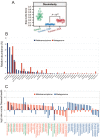Metatranscriptome of the Oral Microbiome in Health and Disease
- PMID: 29518346
- PMCID: PMC5958373
- DOI: 10.1177/0022034518761644
Metatranscriptome of the Oral Microbiome in Health and Disease
Abstract
The last few decades have witnessed an increasing interest in studying the human microbiome and its role in health and disease. The focus of those studies was mainly the characterization of changes in the composition of the microbial communities under different conditions. As a result of those studies, we now know that imbalance in the composition of the microbiome, also referred to as microbial dysbiosis, is directly linked to developing certain conditions. Dysbiosis of the oral microbiome is a prime example of how this imbalance leads to disease in the case of periodontal disease. However, there is considerable overlap in the phylogenetic profiles of microbial communities associated with active and inactive lesions, suggesting that the difference in periodontal status of those sites may not be explained solely by differences in the subgingival microbial composition. These findings suggest that differences in functional activities may be the essential elements that define the dysbiotic process. Researchers have recently begun to study gene expression of the oral microbiome in situ with the goal of identifying changes in functional activities that could explain the transition from health to disease. These initial results suggest that, rather than a specific composition, a better understanding of oral dysbiosis can be obtained from the study of functional activities of the microbial community. In this review, we give a summary of these initial studies, which have opened a new door to our understanding of the dynamics of the oral community during the dysbiotic process in the oral cavity.
Keywords: caries; dysbiosis; metagenome; microbiota; periodontitis; transcriptome.
Conflict of interest statement
The authors declare no potential conflicts of interest with respect to the authorship and/or publication of this article.
Figures





Similar articles
-
Metatranscriptomic analyses of the oral microbiome.Periodontol 2000. 2021 Feb;85(1):28-45. doi: 10.1111/prd.12350. Epub 2020 Nov 23. Periodontol 2000. 2021. PMID: 33226688 Review.
-
Human oral microbiota and its modulation for oral health.Biomed Pharmacother. 2018 Mar;99:883-893. doi: 10.1016/j.biopha.2018.01.146. Epub 2018 Feb 20. Biomed Pharmacother. 2018. PMID: 29710488 Review.
-
Identification of the Bacterial Biosynthetic Gene Clusters of the Oral Microbiome Illuminates the Unexplored Social Language of Bacteria during Health and Disease.mBio. 2019 Apr 16;10(2):e00321-19. doi: 10.1128/mBio.00321-19. mBio. 2019. PMID: 30992349 Free PMC article.
-
Protein relative abundance patterns associated with sucrose-induced dysbiosis are conserved across taxonomically diverse oral microcosm biofilm models of dental caries.Microbiome. 2015 Dec 19;3:69. doi: 10.1186/s40168-015-0136-z. Microbiome. 2015. PMID: 26684897 Free PMC article.
-
Small RNA Transcriptome of the Oral Microbiome during Periodontitis Progression.Appl Environ Microbiol. 2015 Oct;81(19):6688-99. doi: 10.1128/AEM.01782-15. Epub 2015 Jul 17. Appl Environ Microbiol. 2015. PMID: 26187962 Free PMC article. Clinical Trial.
Cited by
-
Formulation and Evaluation of Characteristics, Remineralization Potential, and Antimicrobial Properties of Toothpaste Containing Nanohydroxyapatite and Nanosilver Particles: An In Vitro Study.Int J Clin Pediatr Dent. 2024 Jun;17(6):630-636. doi: 10.5005/jp-journals-10005-2855. Int J Clin Pediatr Dent. 2024. PMID: 39391146 Free PMC article.
-
A novel phage from periodontal pockets associated with chronic periodontitis.Virus Genes. 2019 Jun;55(3):381-393. doi: 10.1007/s11262-019-01658-y. Epub 2019 Mar 29. Virus Genes. 2019. PMID: 30927185
-
Mechanism of Action of Streptococcus downii, a New Bacterial Species with Probiotic Potential.Antibiotics (Basel). 2023 Sep 21;12(9):1472. doi: 10.3390/antibiotics12091472. Antibiotics (Basel). 2023. PMID: 37760768 Free PMC article.
-
Current State and Challenges of the Global Outcomes of Dental Caries Research in the Meta-Omics Era.Front Cell Infect Microbiol. 2022 Jun 17;12:887907. doi: 10.3389/fcimb.2022.887907. eCollection 2022. Front Cell Infect Microbiol. 2022. PMID: 35782115 Free PMC article. Review.
-
Periodontitis may induce gut microbiota dysbiosis via salivary microbiota.Int J Oral Sci. 2022 Jun 23;14(1):32. doi: 10.1038/s41368-022-00183-3. Int J Oral Sci. 2022. PMID: 35732628 Free PMC article.
References
-
- Booijink CCGM, Boekhorst J, Zoetendal EG, Smidt H, Kleerebezem M, de Vos WM. 2010. Metatranscriptome analysis of the human fecal microbiota reveals subject-specific expression profiles, with genes encoding proteins involved in carbohydrate metabolism being dominantly expressed. Appl Environ Microbiol. 76(16):5533–5540. - PMC - PubMed
-
- Byrne SJ, Dashper SG, Darby IB, Adams GG, Hoffmann B, Reynolds EC. 2009. Progression of chronic periodontitis can be predicted by the levels of Porphyromonas gingivalis and Treponema denticola in subgingival plaque. Oral Microbiol Immunol. 24(6):469–477. - PubMed
-
- Charalampakis G, Dahlén G, Carlén A, Leonhardt A. 2013. Bacterial markers vs. clinical markers to predict progression of chronic periodontitis: a 2-yr prospective observational study. Eur J Oral Sci. 121(5):394–402. - PubMed
Publication types
MeSH terms
Grants and funding
LinkOut - more resources
Full Text Sources
Other Literature Sources
Medical
Research Materials

